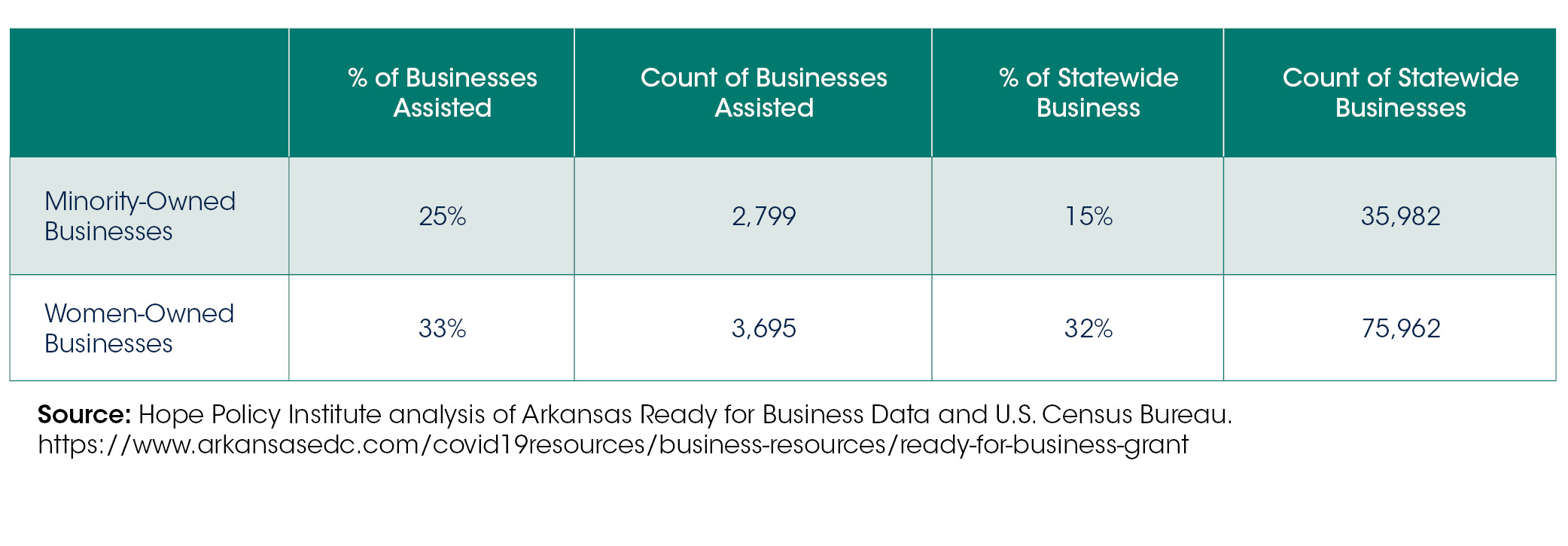Review of Arkansas Ready for Business Program: Gaps and Opportunities
July 29th, 2020
Overview
The Arkansas Ready for Business program provided direct grants to over 11,000 businesses across the state that are grappling with the economic crisis brought on by COVID-19. The Arkansas Legislative Council approved the use of federal funds provided through the CARES Act Coronavirus Relief Fund to the State of Arkansas. Although $147 million was originally allocated for the program, final award amounts totaled over $128 million, covering 222,000 employees, both full and part time.[1] Grant amounts ranged from $500 to the maximum $100,000, with an average grant amount of just $11,391. The grant amounts were calculated by looking at the type of business and number of employees, and could be used for COVID-related expenses such as personal protective equipment, but not for expenses like payroll.[2] Importantly, the program ensured that at least 15% of grant dollars would go to minority and women-owned businesses.
Although Arkansas recognized that small businesses were struggling and a grant program with a minority-set aside is a helpful intervention, the program’s outcome shows there were gaps leaving some of the most impacted businesses behind. The data shows that very few of the $128 million grant dollars reached the most financially vulnerable communities. Just 8% of total dollars went to persistent poverty counties, meaning they have had poverty rates greater than 20% for more than 30 years. Only 5% of grant dollars went to counties where the majority of residents are people of color. See Table 1.
Table 1: Median and Average Grant Allocation by County Type as June 26, 2020
As the cases of coronavirus skyrocket, minority and women-owned businesses continue to suffer disproportionately from the economic fallout. For example, the number of Black-owned businesses has declined by 40% since the pandemic, compared with 17% of white-owned businesses.[3] These businesses have struggled to access federal aid programs designed to mitigate the damage. The $600 billion federal relief program, Paycheck Protection Program (PPP) bypassed many minority-owned businesses.[4] Even before COVID, data from the Brookings Institute found that large banks approved 60% of loans by white business owners, compared to just 50% of loans by Hispanic business owners and 29% of loans by Black business owners.[5] Data from the program provides insight in to its reach to hardest hit business owners in Arkansas. See Table 2.
Tables 2: Share of Minority and Women-Owned Businesses Assisted by the Grant as of June 26, 2020
 Challenges
Challenges
Initially, the program underestimated the need for assistance by allocating only $15 million for small business relief. All the money was accounted for within the first hour, with many businesses still unaware of the program’s existence.[6] The second round of the program rolled out 6 days later on May 5, 2020. The Arkansas Legislature approved $147million for additional small business relief, however the window to apply was only open for 48 hours.[7] It is unclear what outreach, if any, happened to reach the hardest hit, and underserved businesses. With several relief programs happening simultaneously, business owners may have had a hard time determining the specific documents and requirements for the AR Ready for Business program compared to others such as PPP.
Conclusion
Minority and women-owned small businesses faced structural economic challenges before COVID-19 and data shows they continue to be the hardest hit. State programs, like the Arkansas Ready for Business program have the opportunity to fill the gap left by the federal PPP program and existing the financial system but without the right outreach or implementation, strategies may fall short. Any small business relief efforts must take into consideration the racial and gender wealth disparities that adversely affected minority and women business owners’ capacity to start and maintain businesses even before COVID-19. Outreach strategies for relief efforts must be drastically more extensive reaching persistent poverty counties and majority people of color counties. Hope Credit Union’s outreach strategy for PPP lending provides a contrasting example to show that more can be done to reach historically underserved communities. Over 60% ($2.1 million) of HOPE PPP lending in Arkansas went to counties where the majority of residents are people of color (all of which are persistent poverty counties). And, 62% ($2.2 million) persistent poverty counties in the state.
Federal and state relief coupled with proper outreach and technical assistance can and should be a lifeline to small businesses hardest hit by COVID-19.
[1] Arkansas Economic Development Commission, Ready for Business Grant, https://www.arkansasedc.com/covid19resources/business-resources/ready-for-business-grant-program. Accessed on July 24, 2020.
[2] Thompson, D. July 5, 2020. State Business Grants to Fight Virus Run Well Compared to Other States, Business Leaders Say. https://www.arkansasonline.com/news/2020/jul/05/state-business-grants-to-fight-virus-run-well/
[3] Fairlie, R. June 2020. The Impact of COVID-19 on Small Business Owners. https://www.nber.org/papers/w27309.pdf
[4] Harrington, A. June 17, 2020. Paycheck Protection Program: Loan Forgiveness and Other Challenges. https://www.responsiblelending.org/sites/default/files/nodes/files/research-publication/crl-testimony-harrington-house-smallbusiness-17jun2020.pdf
[5] Liu, S. Parilla, J. April 14, 2020. Businesses Owned by Women and Minorities Have Grown. Will COVID19 Undo That? https://www.brookings.edu/research/businesses-owned-by-women-and-minorities-have-grown-will-covid-19-undo-that
[6] Brantley, M. April 30, 2020. Ready for Business State Grant Money Gone in an Hour. https://arktimes.com/arkansas-blog/2020/04/30/ready-for-business-state-grant-money-gone-in-an-hour-will-there-be-more-who-got-it
[7] Hale, T. May 4, 2020. Arkansas Ready for Business Program Application Goes Online on Tuesday. https://armoneyandpolitics.com/arkansas-ready-for-business-program-application-goes-online-on-tuesday-may-5/







